Combatives Teaching Techniques
WARM-UPS AND STRETCHES
Before combatives training, the soldier must be prepared for the upcoming physical stress. A warm-up period gradually increases the internal temperature of the body and the heart rate. Stretching prepares the ligaments, tendons, muscles, and heart for a workout, decreasing the chances of injury. After the initial warm-up, training drills can be used to further warm up. This allows for the maximum use of training time combining a portion of the warm up with building muscle memory, and refining the basic techniques.
a. Warm-up Exercises. To begin warm-up exercises, rotate the major joints; neck, shoulders, hips, and knees. The warm-up should include at least 7 to 10 minutes of stretching, running in place or jogging around the training area, and calisthenics. Grass drills and guerrilla exercises are good to use as a warm-up for combatives training. They condition the body through motion in all ranges, accustom the soldiers to contact with the ground, and promote aggressiveness.
b. Stretching Exercises. Any of the stretching exercises in FM 21-20 are recommended for hand-to-hand combat training. Five other exercises that increase flexibility in areas of the body that benefit hand-to-hand combat movements are as follows:
(1) Backroll Stretch.
(a) Position. Lay on ground on back with legs extended and arms by sides, palms down.
(b) Action. Raise legs over head and roll back as far as possible, trying to place toes on the ground behind head. Keep knees locked and feet and knees together; hold for 20 seconds (Figure Below). Gradually return to starting position. Repeat two or three times.
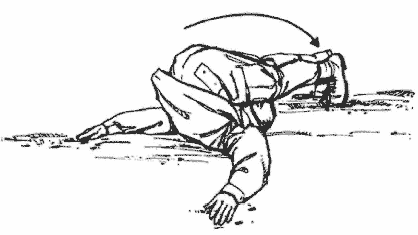
Backroll Stretch
(2) Buddy-Assisted Splits (Leg Spreader).
(a) Position. Sit on ground facing buddy with legs extended and spread as far as possible. Position feet inside ankles of buddy.
(b) Action. Interlock hands with buddy and alternate pulling one toward the other, causing the buddy to bend forward over the hips until a stretch is felt (Figure Below). Hold this position for 20 seconds, then alternate and have him pull you into a stretch. Do sequence two or three times.
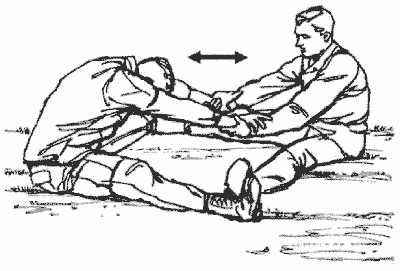
Buddy-Assisted Splits (Leg Spreaders)
(3) Buddy-Assisted Hamstring Stretch.
(a) Position. Sit on ground with right leg extended to front and foot pointing up. Bend left leg with sole touching to inside of the right thigh. Have buddy kneel behind you with his hands on your shoulders (Figure Below).
(b) Action. Slowly bend forward from hips over the right leg and reach your hands toward ankles until stretch is felt (Figure Below). Hold this for 10 to 15 seconds. The buddy then applies downward pressure and allows you to adjust your stretch. Hold for 10 to 15 seconds and repeat. Alternate legs and positions after two or three sequences.
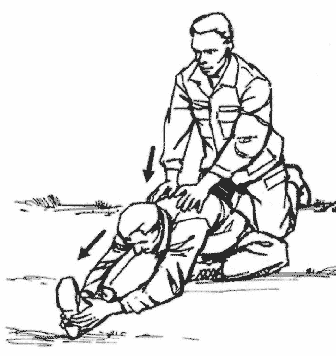
Buddy-Assisted Hamstring Stretch
(4) Buddy-Assisted Groin (Butterfly) Stretch.
(a) Position. Sit on ground with the soles of your feet together, close to the torso. Hold ankles with hands. Have buddy kneel behind you with his hands on your knees.
(b) Action. The buddy places his hands on top of your thighs at the knees. The buddy’s weight is supported by your shoulders while little weight is placed on the thighs. Then, the buddy increases downward pressure on your thighs until stretch is felt (Figure Below). Hold for 20 seconds, then alternate positions.
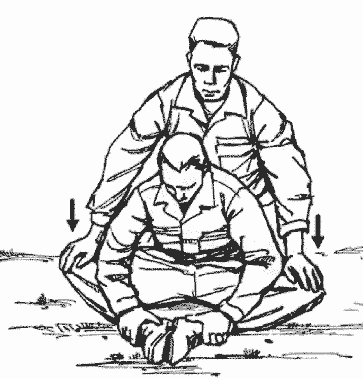
Buddy-Assisted Groin (Butterfly) Stretch
(5) Buddy-Assisted Back Stretch.
(a) Position. Stand back-to-back with buddy and interlock arms at your sides.
(b) Action. Bend forward at the waist and pull buddy up on your back over your hips. The buddy allows his back to arch and tells you when an adequate stretch is felt (Figure Below). Hold this position for 20 seconds, then, change places.
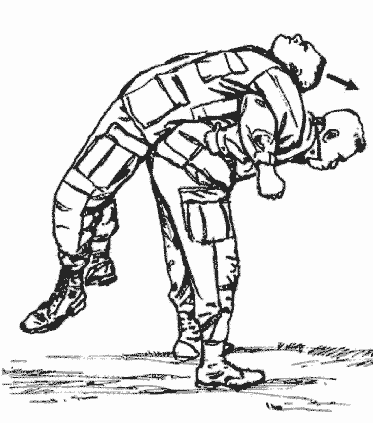
Buddy-Assisted Back Stretch
CRAWL, WALK, AND RUN
Training can be conducted using the crawl, walk, and run techniques, which may be applied on two levels.
a. First Level. The instructors use these techniques during each initial training session.
(1) Crawl Phase. New techniques are introduced, taught, demonstrated, and executed by the numbers.
(2) Walk Phase. During this phase, soldiers practice the new techniques by the numbers, but with more fluid movement and less instructor guidance.
(3) Run Phase. Soldiers execute the techniques at combat speed with supervision.
b. Second Level. The instructors use these techniques when developing unit combatives programs. Before conducting combatives training, the instructor considers the abilities and experience level of the soldiers to be trained. During training, those soldiers with prior martial arts experience can be a great asset; they may be used as demonstrators or as assistant instructors. The crawl, walk, run approach to unit training ensures a high skill level throughout the unit and minimizes the risk of training injuries.
(1) Crawl Phase. During the crawl phase, the instructor introduces combatives to the unit. Here, the basic skills that set the standards for advancement to other levels are mastered. Emphasis is placed on the basic ground fighting techniques, gradually introducing standup fighting and fight strategy. Studying the new techniques in this method ensures that the movements are correctly programmed into the soldiers’ subconscious after a few repetitions.
(2) Walk Phase. Once a unit has developed a sufficient proficiency level in basic skills, begin the walk phase. Instructors introduce soldiers to more advanced ground fighting techniques and begin serious training on closing with the enemy and takedowns. Soldiers engage in full sparring and competitive matches.
(3) Run Phase. In the run phase, soldiers spar using slaps to represent striking during ground fighting, takedowns are practiced against an opponent with boxing gloves, and scenario driven training such as multiple opponent or restrictive equipment is used.
DEMONSTRATIONS
A well-coordinated demonstration and professional demonstrators are crucial for successful learning by soldiers. Unrehearsed presentations or inadequately trained demonstrators can immediately destroy the credibility of the training. Two methods are appropriate for demonstrating combative techniques based on the size of the group to be taught.
a. Company-Size Formation or Larger. The instructor or demonstrator uses the talk-through method. The primary instructor talks the demonstrators through the techniques by the numbers, and then the demonstrators execute at combat speed. The soldiers can see how to apply the move being taught in relation to the instructor or demonstrator. The primary instructor is free to control the rate of the demonstration and to stress key teaching points. The demonstrators must be skilled in properly applying the techniques so soldiers can adequately grasp the intended concepts.
b. Platoon-Size Formation or Smaller. A good method for demonstrating to a smaller formation is for the primary instructor to apply the technique being taught to an assistant instructor. The primary instructor talks himself through the demonstration. He stresses correct body movement and key teaching points as he does them.
EXECUTION BY THE NUMBERS
Instructors use execution by the numbers to break techniques down into step-by-step phases so soldiers can clearly see how the movements are developed from start to finish. Execution by the numbers also provides soldiers a way to see the mechanics of each technique. This teaching method allows the instructor to explain in detail the sequence of each movement. For example, on the command PHASE ONE, MOVE, the attacker throws a right-hand punch to the defender’s face. At the same time, the defender steps to the inside of the attacker off the line of attack and moves into position for the right-hip throw. Assistant instructors are able to move freely throughout the training formation and make on-the-spot corrections.
EXECUTION AT COMBAT SPEED
When the instructor is confident that the soldiers being trained are skilled at executing a technique by the numbers, he has them execute it at combat speed. Executing movements at combat speed enables soldiers to see how effective a technique is. This builds the soldier’s confidence in the technique, allows him to develop a clear mental picture of the principles behind the technique, and gives him confidence in his ability to perform the technique during an actual attack. For example, the command is, PASS THE GUARD AT COMBAT SPEED, MOVE. The soldiers then execute this technique from start to finish. It is important to remember that combat speed does not always mean very quickly. Speed requires space and space often favors the defender.
DRILLS
Drills are used to warm up, to reinforce the importance of dominant body position, and to perfect soldiers’ basic skills through repetition. During these drills, basic positional techniques are repeated at the beginning of each training session with a different detail emphasized each session. In this way the emphasis is kept on perfecting the basic techniques, while at the same time making the best use of limited training time.
TRAINING PADS AND OTHER PROTECTIVE EQUIPMENT
Training pads are highly recommended to enhance training. They allow full-forced strikes by soldiers and protect their training partners. Although striking is a inefficient way to end a fight, it is a very important part of a fight. Pads enable soldiers to feel the effectiveness of striking techniques and to develop power in their striking. Instructors should encourage spirited aggressiveness. Pads can be tackle dummy pads or martial arts striking pads. Training pads can be requisitioned through supply channels or purchased locally.
a. The use of pads is especially recommended for knee-strike practice drills, and kicking drills. Ideally, the pad is placed on the outside of the training partner’s thigh, protecting the common perennial nerve. Pads can also be held against the forearms in front of the head and face to allow practice of knee or elbow strikes to this area.
b. Other protective equipment, such as shin guards, can also be useful to practice with improvised weapons.